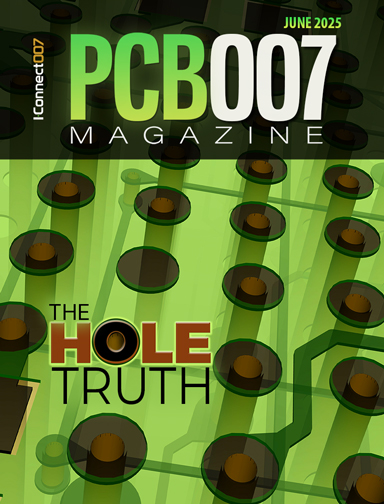-

- News
- Books
Featured Books
- pcb007 Magazine
Latest Issues
Current Issue
Inventing the Future with SEL
Two years after launching its state-of-the-art PCB facility, SEL shares lessons in vision, execution, and innovation, plus insights from industry icons and technology leaders shaping the future of PCB fabrication.

Sales: From Pitch to PO
From the first cold call to finally receiving that first purchase order, the July PCB007 Magazine breaks down some critical parts of the sales stack. To up your sales game, read on!

The Hole Truth: Via Integrity in an HDI World
From the drilled hole to registration across multiple sequential lamination cycles, to the quality of your copper plating, via reliability in an HDI world is becoming an ever-greater challenge. This month we look at “The Hole Truth,” from creating the “perfect” via to how you can assure via quality and reliability, the first time, every time.
- Articles
- Columns
- Links
- Media kit
||| MENU - pcb007 Magazine
Estimated reading time: 6 minutes
Contact Columnist Form
Trouble in Your Tank: Surface Preparation and Cleaning, Part 1
Introduction
Surface preparation and cleaning are essential aspects of metal finishing and printed circuit board fabrication. The printed circuit board fabricator has several processes that fit the broad category of cleaning and surface preparation in its toolbox. It is critical that the engineer carefully evaluates these methods and processes to determine the most effective way to optimize yields.
Overview
In general, surface preparation is done to assure good adhesion of metal, dielectric, photoresist, or soldermask to the prepared surface, although avoiding excessive adhesion could also be the object. Take the example of surface preparation before dry photoresist lamination:
- Failure to achieve good adhesion in a print-and-etch process will cause etchant attack under the resist and ultimately create an “open” defect
- Failure to achieve good adhesion in a plating process will cause tin/lead underplating, ultimately leading to “shorting” defects (shorts)
- Failure to achieve good release of unexposed resist during development can cause etch retardation in a print-and-etch process, ultimately leading to shorts
- Failure to achieve good release of unexposed resist during development can cause poor adhesion of the plated copper to the copper base (“copper-tocopper peelers”) in a plating process
- Failure to achieve good release of exposed resist in a print-and etch process on innerlayers can inhibit the formation of multilayer bonder on such a copper surface
- Failure to achieve good release of exposed resist in a plating process can cause etch retardation
- Failure to remove residues including chromates, organic soils (including resin spots) will adversely affect innerlayer bonding and plating quality
Figure 1 depicts an example of both an open and short due to improper surface preparation leading to poor adhesion. Figure 2 shows a schematic of poor adhesion leading to resist lifting. As a result, the poor adhesion leads to etching away of copper.
Figure 1: Short circuit (left) and open circuit (right) due to insufficient resist adhesion.
Figure 2: Innerlayer showing poor resist adhesion (left) and result after etching (right).
Understanding Surface Preparation Issues
To fully grasp some of the surface preparation issues encountered in the PCB fabrication process, a short primer on the copper foil manufacturing process follows. This will enhance the reader’s understanding of the composition and topography of standard electrodeposited (ED) foils and reverse-treated foils (drum-side treated foils).
Figure 3: Manufacturing of electrodeposited copper foil. (Source: Oak-Mitsui Copper Company)
Page 1 of 2
More Columns from Trouble in Your Tank
Trouble in Your Tank: Minimizing Small-via Defects for High-reliability PCBsTrouble in Your Tank: Metallizing Flexible Circuit Materials—Mitigating Deposit Stress
Trouble in Your Tank: Can You Drill the Perfect Hole?
Trouble in Your Tank: Yield Improvement and Reliability
Trouble in Your Tank: Causes of Plating Voids, Pre-electroless Copper
Trouble in Your Tank: Organic Addition Agents in Electrolytic Copper Plating
Trouble in Your Tank: Interconnect Defect—The Three Degrees of Separation
Trouble in Your Tank: Things You Can Do for Better Wet Process Control


